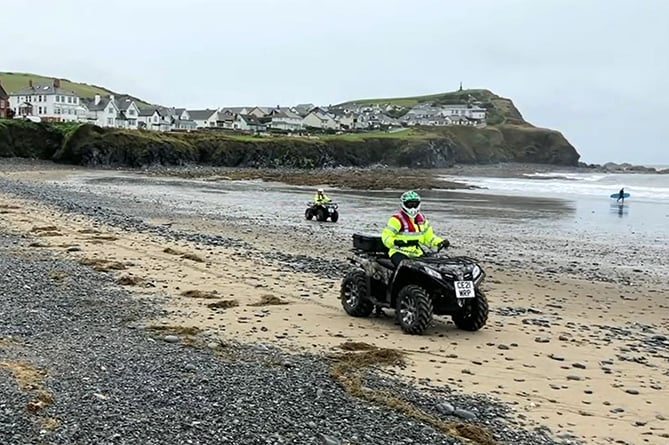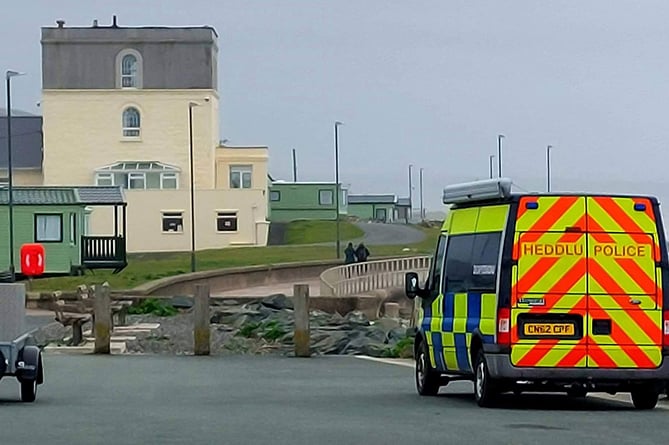On the morning of Saturday, 1 October, a potentially historic haul of suspected cocaine, worth tens of millions of pounds, washed up in packages on Tanybwlch beach in Aberystwyth.
A walker stumbled upon the mysterious chain of containers interlinked to makeshift buoys – emblazoned with Dior branding – and reported it to the police.
The call triggered a major investigation launched by the National Crime Agency – the UK’s FBI – Dyfed-Powys Police, neighbouring forces and the National Police Air Service.
In the hours and days that followed, more packages washed up on beaches along Cardigan Bay.
Just for a moment, surrounding communities and the coasts on which they are situated bore witness to scenes that wouldn’t look out of place on the golden sands of Miami, the ports of Dublin or any location known to be at the centre of the global illegal drug trade.
Helicopters flew overhead, police boats crashed through waves and a conspicuous police presence caused disquiet in several towns and villages along the coastline.
Waitress at The Sands Bistro cafe in Borth, Ella Thomas, said the entire area was overcome with ‘a weird excitement’.
She said crowds formed in the coastal village as five police vehicles, marked and unmarked, descended on the beach. She estimated that about 20 officers were on the scene.
A police helicopter hovered up and down, appearing to scour the shoreline for any other parcels.
“When we saw the helicopter flying low over the beach, we guessed what it would be about,” she said.
“It was like being in a police drama.”
National newspapers began to speculate about the price of the initial haul which was thought to be comprised of around 30 packages.
The NCA has now confirmed that the drugs recovered weigh 1,200kg and are worth about £42 million.
Many newspapers estimated the price of the haul of the Class A substance would be close to £100m – which would have made it one of the largest ever to wash up on a UK beach.
It could still be the biggest ever to come ashore on a Welsh beach.
But where did the drugs come from? Why Cardigan Bay? And who might they belong to?
Unfortunately, with the authorities remaining typically tight-lipped, most of the answers to these questions remain a mystery.
The NCA is leading the investigation and the Cambrian News sent over numerous questions to its press team.
We asked about the history of drugs shipments washing ashore in Wales (and the UK) and whether it was common for criminals to opt for this particular method of importation.
We asked which are the best-used routes for trafficking cocaine into the UK and we also hoped for a steer on where the drugs could have come from.
In response, an NCA spokesperson said: “The NCA continues to work closely with Dyfed-Powys Police around the consignment which washed up on the beach earlier this month.
“Forensic work continues on the substance found in the bags, but we believe it to be cocaine weighing approximately 1,200 kilos.
“This amount would have a wholesale value of approximately £42m.
“Our investigation continues and we reiterate to the public that if they find anything suspicious on the beaches, please contact police.”

The press officer added: “Large quantities of cocaine washing ashore will result from the global drugs trade, but causes will vary and this does not occur frequently in the UK.”
The Police and Crime Commissioner for the Dyfed-Powys region, Dafydd Llywelyn, told a public meeting at Aberystwyth University that people have nothing to fear.
“I was shocked to hear that we’d found approximately a ton of suspected cocaine on a beach not far from here,” he said.
“But it isn’t unique, is the point.
“A few years ago, there was a large seizure of cocaine in Fishguard port, which is a relatively small port.”
He is believed to be referencing a 750kg haul of cocaine worth more than £60m which was seized from a yacht in the coastal town in Pembrokeshire.
“In a meeting this week, I asked the NCA for reassurance that the west coast port area wasn’t a vulnerability in UK infrastructure from a policing point of view,” he added.
“But the sheer geography of the landscape and coastline means it will always be a space criminals seek to penetrate.
“The challenge for police along this stretch is to provide a visible presence and to act on intelligence.”
His office had not seen previous instances of cocaine packages with Dior marketing logos coming ashore.
At the same meeting, the Dyfed-Powys Police Chief Constable Dr Richard Lewis – who is also the National Police Chiefs’ Council lead for drug crime – added: “We’re an island nation and we will always have ports or areas of coastline which are more exposed to all sorts of problems, not just drug importation.
“But I would like the public to know there is nothing specific about Aberystwyth being a vulnerability.
“It isn’t. We’re on the west coast of the UK and that presents some problems in terms of where importations come from.
“But this does not link to any county lines drug operations as far as we know.
“Because this business model is simply intended to get contraband into the country.
“Of course, it is disquieting that a large amount of a Class A substance washed up here but it is not for use in this area.”
The number of kilograms the packages of drugs at Tanybwlch beach weighed, according to the National Crime Agency
But why Cardigan Bay?
Let’s consider the location. Tanybwlch, at the centre of Cardigan Bay, is roughly 108 miles away from Dublin, as the crow flies.
It is also situated below major port cities like Liverpool and Belfast.
A map of ‘the main cocaine trafficking flows by reported seizures’ from the United Nations Office on Drugs and Crime shows two of the best-used global routes for shipping the drug flow into Western Europe from the United States and Mexico.
The routes travel just below the Irish Sea and pass the southern most points of England.
To the south of Dublin, on a significant stretch of coastline, are the towns of Wicklow, Courtown and Wexford. Nearly a hundred miles of Irish Sea water separates them and the coasts of Ceredigion.
Gang and drug crime is not just folklore in Ireland but an all too often brutal reality – with the Kinahan and the Byrne cartels infamous the world over.
Most of the world’s cocaine originates in South America — to which the coca bush is a native species – but particularly Bolivia, Peru and Colombia.
As mentioned, seafaring methods of drug importation are also nothing new.
Since the turn of the century, there have been hauls worth between £10m and £80m discovered on beaches in Norfolk, Sussex and Cornwall.
Other trafficking methods involve boats – large or small. About £80m of cocaine was seized from a fishing trawler off the coast of Falmouth in Cornwall, while larger shipments – such as the £170m worth which was intercepted in Portsmouth – travel via larger cargo vessels.
The largest in UK history was seized on a boat in Aberdeen in 2015, worth £500m.
But in 2008, a series of separate landings saw packages of cocaine wash up in Cornwall but also in several places along the Welsh coastline.
In response to this month’s incident, experts are speculating that, judging by similar cases, the makeshift buoys kept afloat the drug haul anchored in the middle of the ocean ready for collection from criminals.
It could have been the stormy weather that saw the packages drift towards Welsh shores from the Irish Sea.
The Cambrian News sent several questions to Garda, the Irish police force, asking whether it had any knowledge of the haul, whether drugs are known to wash up on Irish beaches and if the method used indicated where the cocaine came from or who it belongs to.
We received the following response: “We have issued no press releases relating to any drug seizure of this size.” Which certainly reinforces the rarity of a haul this size, if nothing else.
We asked similar questions to Interpol and the Irish coastguard and we await responses.
The Cambrian News asked the NCA, Dyfed-Powys Police, the PCC, the Home Office, Garda, Interpol and the UN Office on Drugs and Crime whether there are any previous drug seizures which involved packaging marked with the Dior label.
Not one of them provided an answer to our specific questions or provided any information on previous cases.
But on 17 August this year, a man in Biloxi, a small town in Mississippi, US, found 11 packages of cocaine that had washed ashore on a nearby beach.
All 11 parcels of cocaine were marked with the Dior label, according to local newspaper The Sun Herald.
South America, to the US, Ireland and then Cardigan Bay? It’s a working theory at least.
But Dior packages have also been spotted in Australia years ago.
And there are other clues.
A Flight Radar video shows a small private charter propeller plane taking off from the island of Jersey at around 2.30pm on Saturday, hours after the drugs were found.
As reported by residents, it flew up and down Cardigan Bay – performing occasional circular motions over particular areas of the coast, including Aberystwyth and Barmouth – and then eventually touched down in Doncaster at about 6pm.
Could this be the dealers after realising they had lost £42m worth of produce tailing back to locate it before the police did?
Others say it is equally possible, as with previous cases, that the drugs floated all the way over the Pacific Ocean from the Americas.

The Cambrian News spoke with professor in law and forensic psychology from Aberystwyth University, Gareth Norris, who has also worked with the Home Office and international partners investigating organised crime, county lines and the global drug trade.
He said: “The drugs weren’t meant to wash up there.
“It is most likely they were all purposely tied together and were intended to be in the water for a period of time until someone could collect them.
“Sometimes drugs can be thrown overboard because police or the coastguard might be there. Sometimes they get thrown out of airplanes into the sea and then a boat will pick them up.
“If you’re selling to someone else you run the risk that they are the police or the police could be following.
“Drugs will be left places, even in trucks and vans. And when they’re left in the water, they often have GPS trackers.
“The dealers don’t want to be around. They could have come from anywhere but it’s possible they came from Ireland.
“If they’ve come from America, it will usually be on a boat and it will then come into a location in the Irish Sea. But it could easily have come from a port, like Liverpool or Belfast.
“This is a significant amount of drugs and someone will want it back. It will certainly be a well-organised gang.
“It’s quite unusual to see this happen in the UK. But if you look at some of the old smuggling routes, the west coast of Wales was a point for smuggling drugs from the US and Ireland so there is a history of it.”
The quantities of cocaine seized by authorities in England and Wales increased in size by 161 per cent as of early last year, latest available UK Government figures show.
The data suggests that importation of larger quantities such as this is a growing problem for authorities.
The Cambrian News was first to break the true valuation of the haul as other media outlets speculated incorrectly.
We will continue to question the NCA and Dyfed-Powys Police who did not respond to our specific questions about the history of drug trafficking on the area’s coastlines nor did they confirm exactly where packages have appeared.
We will also return to them for confirmation of the types of substances that washed up —and their purity.
Only days ago, more police were seen scouring the shoreline in Borth and Tywyn.
Police have warned the public that other packages could wash up.
As more details become available, we will keep you updated. In the meantime, watch out for more high tides.





Comments
This article has no comments yet. Be the first to leave a comment.